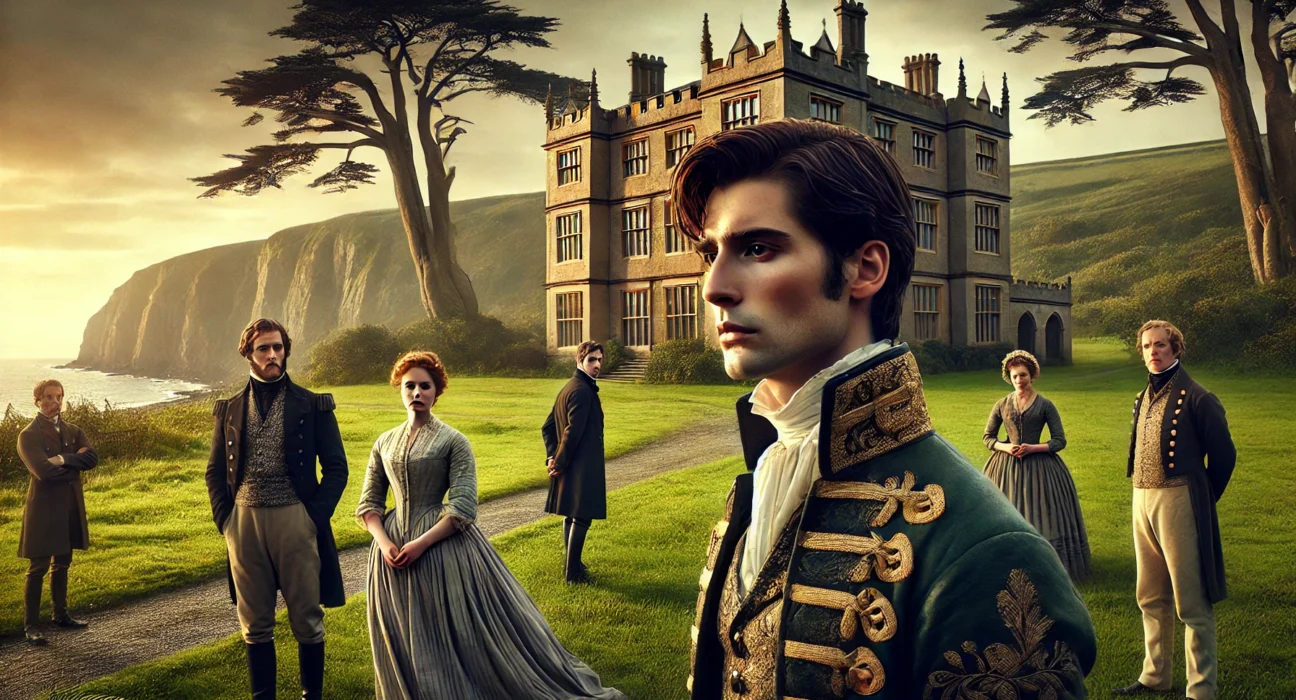“An Eye for an Eye” is a novella written by Anthony Trollope and published in 1879. Set against the backdrop of England and Ireland, it explores themes of morality, duty, love, and the consequences of impulsive actions. The story revolves around a young Englishman, Fred Neville, who is heir to the Scroope earldom. While serving in the army, Fred embarks on a passionate romance with an Irish Catholic girl, Kate O’Hara. His conflicting obligations between love and family duty lead to tragic consequences, emphasizing the idea that vengeance and reckoning—symbolized by the title’s reference to “an eye for an eye”—can have devastating effects.
Plot Summary
Fred Neville, a young Englishman destined to inherit the earldom of Scroope, is restless and eager to embrace life before settling into the weight of responsibility that awaits him. Raised with the expectation that he will one day take his place as the Earl, Fred is aware of the strictures of his class. His uncle, the current Earl of Scroope, a somber man filled with a sense of duty and tradition, anticipates Fred’s eventual marriage to a suitable young woman from their own world, ensuring the continuity of their noble line.
Fred, however, has other plans. Enlisted as an officer in the army, he finds a freedom in Ireland that he feels England denies him. The wild beauty of the Irish landscape and the adventures he embarks upon stir his sense of romance and independence. But it is in County Clare, near the rugged cliffs of Moher, that Fred encounters the spirited and beautiful Kate O’Hara. Their meeting ignites a passionate love affair, a stark contrast to the measured life awaiting him back in England. Kate, an Irish Catholic, lives a simple life with her mother, Mrs. O’Hara, in a modest cottage. To her, Fred is everything—a gallant hero, the promise of love and a future beyond the confines of her rural world.
Kate’s love for Fred is pure and all-consuming. She believes his promises, as does her mother, who encourages the match despite their different social standings. Fred, captivated by Kate’s beauty and charm, makes promises of marriage, but deep within, he knows that fulfilling such a vow would bring disgrace upon his family. His affair with Kate grows more intense, and for a time, he convinces himself that love might conquer all, even the expectations of his title and the demands of his heritage.
Mrs. O’Hara is a shrewd woman, proud of her daughter and determined to secure Fred’s commitment. She presses Fred, knowing that their circumstances as poor Catholics place them at a disadvantage in a world governed by English aristocracy and Protestant norms. Fred, caught between his love for Kate and his duty to his family, begins to falter. The weight of his inheritance looms larger each day, and the looming presence of his uncle’s expectations becomes impossible to ignore.
Back in England, the Earl and his wife, Lady Scroope, are unaware of Fred’s entanglement. They continue to believe that he will fulfill his responsibilities and marry within his class. Fred, meanwhile, is tormented by indecision. He cares for Kate, but he also understands that their relationship is unsustainable. His family would never accept her, and his future as the Earl cannot include an Irish Catholic wife from such a low station. In his heart, Fred knows he must end the affair, but he lacks the courage to face the consequences of breaking Kate’s heart.
Fred’s leave from his regiment comes to an end, and he returns to Ireland for what he knows must be his final days with Kate. Yet, even as the moment of reckoning approaches, he continues to evade the truth. Kate, hopeful and devoted, dreams of the life they will share together. She trusts Fred completely, believing that their love will transcend the boundaries of class and religion. She waits eagerly for him to fulfill his promise of marriage.
But Fred’s resolve begins to crumble. Back in Ireland, he feels the tightening grip of his duty. As heir to the earldom, he knows that his family’s reputation is at stake. He cannot bring himself to defy the Earl, the family, and the long-standing traditions that bind him. Yet, he also cannot face the devastation his decision will bring upon Kate. Torn between love and obligation, Fred chooses the path that he believes will secure his future—he will abandon Kate and return to England, leaving her without explanation, hoping that time and distance will ease the pain.
The break is brutal. Kate, bewildered and heartbroken, realizes what Fred has done. She retreats into a state of despair, unable to comprehend how the man she loved so completely could betray her so thoroughly. Her mother, outraged and filled with a desire for vengeance, confronts Fred. She demands that he honor his promise to her daughter, but Fred, by now fully resigned to his duty as the future Earl, refuses. His decision, once made, is final.
Fred returns to Scroope Manor, where he is received as the dutiful heir. His uncle and aunt are relieved that Fred has avoided scandal and seems prepared to assume the responsibilities of his title. Yet, Fred’s conscience is not so easily placated. The image of Kate, the memory of her love and trust, haunt him. He tries to convince himself that he has acted in the only way possible, but his guilt lingers.
Meanwhile, Kate’s condition worsens. The betrayal destroys her spirit, leaving her fragile and broken. The weight of Fred’s rejection, combined with the loss of her hopes and dreams, drives her to madness. Mrs. O’Hara, devastated by her daughter’s suffering, becomes consumed by thoughts of revenge. In her heart, she believes that Fred’s betrayal has earned him a terrible punishment—an eye for an eye.
When the final blow falls, it comes with swift, tragic force. Mrs. O’Hara, unable to bear the sight of her daughter’s ruin and driven by her own sense of justice, exacts her revenge on Fred. Kate, who had loved Fred with all her heart, becomes a symbol of the destructive power of love and the consequences of a broken promise. The tale concludes with Fred’s realization that his choices, dictated by duty and societal expectations, have led not only to his own emotional ruin but to the devastation of those who loved him most.
Main Characters
Fred Neville: The protagonist, Fred is a charming but impulsive young man who is the heir to the Earl of Scroope. Though expected to assume his responsibilities as an English nobleman, Fred becomes entangled in a romance with Kate O’Hara, which drives the central conflict. His internal struggle between personal desire and social expectations defines his character arc.
Kate O’Hara: A passionate and proud Irish Catholic girl, Kate is deeply in love with Fred. Her character is marked by intense emotions and a strong sense of loyalty. She hopes for a future with Fred, despite the challenges posed by their differing social statuses and religions. Kate’s love and eventual betrayal lead to her emotional undoing.
Mrs. O’Hara: Kate’s mother, Mrs. O’Hara, is a determined and protective woman, fiercely devoted to her daughter. She sees Fred’s promise of marriage as Kate’s path to a better life and pressures Fred to keep his word. Her tragic role reflects the vulnerability of women in a male-dominated society.
The Earl of Scroope: Fred’s uncle and the head of the Scroope family, the Earl embodies tradition, duty, and nobility. He expects Fred to uphold the family’s reputation by marrying into the English aristocracy, thus representing the societal pressure Fred faces throughout the narrative.
Theme
Duty vs. Personal Desire: One of the central themes is the tension between Fred’s obligations to his family and title versus his personal desires, represented by his love for Kate. Trollope explores the consequences of prioritizing individual passion over societal expectations, leading to moral dilemmas and tragic outcomes.
Class and Social Expectations: The novel highlights the rigid class divisions of 19th-century England and Ireland. Fred’s relationship with Kate, a poor Irish girl, starkly contrasts with the expectations set for him as the heir to an English noble estate. Trollope examines how these class differences drive conflict, particularly in terms of marriage and reputation.
Revenge and Retribution: The idea of “an eye for an eye” runs through the story, especially in the way that actions taken for personal vengeance reverberate through the lives of the characters. Mrs. O’Hara’s desire for Fred to honor his promise and the consequences of Fred’s betrayal reflect this motif of retribution.
Religious Tensions: The religious differences between Fred (Protestant) and Kate (Catholic) mirror the historical divide between England and Ireland. Trollope touches on the complex relationship between religion and identity, adding another layer of conflict to Fred and Kate’s doomed romance.
Writing Style and Tone
Anthony Trollope’s writing in An Eye for an Eye is known for its measured and thoughtful prose, combining realism with moral introspection. His sentences are elegantly structured, often reflecting the restrained emotions and societal conventions of the characters. Trollope’s narrative voice is omniscient, offering deep insights into the thoughts and feelings of his characters while maintaining an objective tone. He frequently interjects his own reflections, giving the reader a clear moral lens through which to view the events of the story.
The tone of the novella alternates between somber and reflective, with moments of heightened drama. Trollope skillfully contrasts the pastoral beauty of Ireland with the darkening emotional landscape of his characters, particularly as Fred’s internal conflict deepens. The writing evokes sympathy for both Fred and Kate, while also maintaining a critical eye on the destructive power of unchecked passion and societal pressure. Trollope’s subtle irony and restrained pathos lend the novella its emotional depth without descending into melodrama, making the tragic ending both inevitable and poignant.
We hope this summary has sparked your interest and would appreciate you following Celsius 233 on social media:
There’s a treasure trove of other fascinating book summaries waiting for you. Check out our collection of stories that inspire, thrill, and provoke thought, just like this one by checking out the Book Shelf or the Library
Remember, while our summaries capture the essence, they can never replace the full experience of reading the book. If this summary intrigued you, consider diving into the complete story – buy the book and immerse yourself in the author’s original work.
If you want to request a book summary, click here.
When Saurabh is not working/watching football/reading books/traveling, you can reach him via Twitter/X, LinkedIn, or Threads
Restart reading!








